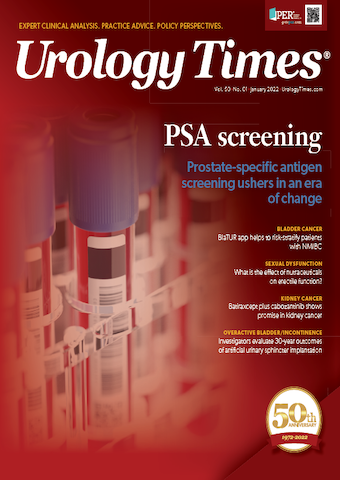Publication
Article
Urology Times Journal
Novel genomic test helps optimize neoadjuvant chemotherapy in bladder cancer
Author(s):
The Decipher Bladder genomic classifier showed the ability to identify tumors that are more likely to respond to neoadjuvant chemotherapy (NAC) in patients with muscle-invasive bladder cancer (MIBC), according to findings from a retrospective multicenter study published in the Journal of Urology.1
While patients with luminal tumors identified by the genomic classifier were found to receive minimal benefit from NAC (NAC) versus non-NAC (overall survival [OS]: 63% vs 65%, respectively), patients with non-luminal classifier-identified tumors received a significant survival benefit with a rate that was 10% higher from NAC versus non-NAC (OS: 71% vs. 61%, respectively).
Yair Lotan, MD

“Our findings are among the first to show the clinical utility of implementing molecular subtyping in order to identify patients for whom NAC is most likely to confer significant benefit,” lead author Yair Lotan, MD, professor of urology and chief of urologic oncology at UT Southwestern Medical Center, stated in a press release.2
The study included 601 patients with MIBC. Of these patients 247 had been treated with NAC and radical cystectomy (RC) and 354 had underwent RC without NAC. Investigators collected specimens from the patients and used the Decipher Bladder genomic classifier to determine molecular subtypes (luminal and non-luminal). Inverse probability treatment weighting was also performed to better compare baseline clinical characteristics between patients treated with NAC versus non-treated patients.
The NAC group had a median age of 65.0 years, tumors were stage cT2 in 76% of this population, and the median follow-up was 2.5 years. The non-NAC group had a median age of 70.2 years, tumors were stage cT2 in 66% of this population with 31 cT1 tumors included, and the median follow-up was 2.9 years. Both groups had similar demographics.
The primary and secondary endpoints were OS and cancer-specific survival (CSS), respectively. These outcomes were measured using Kaplan Meier curves, and cox proportional hazard models.
Results showed that the overall net benefit to OS and CSS was 7% for the NAC group and 5% for the non-NAC group after 3 years. Investigators also found that the NAC group exhibited more pathological downstaging (ypT0 rates of 21.7% versus pT0 rates of 10% in non-NAC group).
Again, the patients with luminal tumors had no significant survival benefit with NAC. On weighted univariable models, luminal tumors showed no benefit versus non-luminal tumors (HR, 0.9, P = 0.7 versus HR, 0.62, P = .02, respectively). Similar outcomes were found on multivariable models (HR, 0.91, P = .3 versus HR, 0.66, P = .04, respectively).
“This study represents meaningful progress in clinically validating biomarkers that are associated with chemotherapy response in patients with MIBC, and it offers hope that we will be able to better manage these patients in the future by accurately selecting those most likely to benefit from additional treatment,” stated Lotan.
References
1. Lotan Y, Jong JD, Liu VYT et al. Patients with muscle invasive bladder cancer with non-luminal subtype derive greatest benefit from platinum based neoadjuvant chemotherapy. Published online September 27, 2021. J Urol. doi:10.1097/JU.0000000000002261
2. New publication demonstrated ability of Veracyte’s Decipher Bladder test to identify tumors most likely to respond to chemotherapy. Published online October 13, 2021. Accessed October 18, 2021. https://www.businesswire.com/news/home/20211013005673/en

































